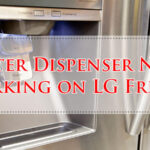A KitchenAid dishwasher not cleaning properly often results from blocked spray arms or a clogged filter. Ensuring these components are clean can significantly improve performance.
Facing issues with your KitchenAid dishwasher failing to leave your dishes spotless can be frustrating and inconvenient. Many homeowners rely on their dishwashers daily, making it essential to address any problems swiftly to maintain the kitchen’s efficiency. Common culprits behind a dishwasher’s poor cleaning performance include food particles clogging the filter, obstructed spray arms, or using the wrong type of detergent.
Addressing these issues not only enhances the dishwasher’s functionality but also extends its lifespan, ensuring it remains a reliable appliance in your kitchen arsenal. Regular maintenance and prompt attention to any signs of trouble can keep your KitchenAid dishwasher operating at its best, ensuring clean, sparkling dishes after every cycle.

Credit: advanceappliance.com
Introduction To Kitchenaid Dishwasher Issues
Kitchenaid dishwashers are known for their durability and efficiency. Yet, like all appliances, they may encounter issues. A common complaint is a dishwasher not cleaning properly. This article delves into the typical signs of cleaning problems and the importance of maintenance. Understanding these can ensure your Kitchenaid dishwasher operates at its best.
Common Symptoms Of Cleaning Problems
Dishwashers that struggle to clean often show clear signs. Look out for these:
- Dishes remain dirty after a cycle
- Spots and streaks on glassware
- Food particles cling to dishes
- Unusual noises during a cycle
These symptoms suggest a cleaning issue. They could point to clogged spray arms or a malfunctioning pump.
Importance Of Regular Maintenance
Regular maintenance keeps your dishwasher in top shape. It prevents common cleaning problems. Aim to:
- Clean filters monthly
- Inspect spray arms for clogs
- Use the right detergent
- Run a cleaning cycle regularly
These steps can extend your dishwasher’s life and ensure it cleans effectively.

Credit: advanceappliance.com
Initial Troubleshooting Steps
Welcome to the initial troubleshooting steps for your Kitchenaid dishwasher. If your dishwasher isn’t cleaning dishes properly, don’t worry. Simple checks can often solve common issues. Let’s start with some basic troubleshooting to get your dishwasher back in top shape.
Checking For Power Issues
First, ensure your dishwasher receives power. A dishwasher without power won’t function correctly. Here’s what to do:
- Check the power cord and outlet.
- Look for tripped circuit breakers.
- Test the outlet with another appliance.
Resolve any power issues before running your dishwasher again.
Ensuring Correct Loading Techniques
Improper loading can block water and detergent. This results in unclean dishes. Follow these tips:
| Item | Tips |
|---|---|
| Dishes | Face them toward the spray arms. |
| Utensils | Place them in designated baskets. |
| Pots and Pans | Put them on the bottom rack. |
Correct loading ensures better cleaning.
Filter Cleaning And Maintenance
If your Kitchenaid dishwasher isn’t cleaning properly, a clogged filter might be the culprit. Regular filter maintenance ensures your dishes come out spotless. Let’s dive into the essentials of keeping the dishwasher filter in tip-top shape.
Locating And Removing The Filter
Identify the filter’s position at the bottom of the dishwasher. Most Kitchenaid models have it beneath the lower spray arm. Twist the filter counterclockwise to release it. Pull the filter up to remove it from the dishwasher.
Step-by-step Cleaning Process
- Rinse the filter under running water to remove debris.
- Use a soft-bristled brush for stuck-on food particles.
- If necessary, soak the filter in warm soapy water for a few minutes.
- After soaking, brush the filter again.
- Rinse the filter thoroughly until the water runs clear.
- Make sure the filter is completely dry before reinstalling it.
- Place the filter back and twist it clockwise to secure.
Clean your filter regularly for the best performance. A clean filter can mean the difference between dirty and sparkling dishes.
Spray Arm Inspection And Cleaning
When dishes come out dirty, the spray arm could be the culprit. This component plays a key role in your Kitchenaid dishwasher’s cleaning process. Over time, food particles and debris can clog the spray arm’s holes. This obstruction stops water from spraying out effectively. Regular inspection and cleaning can restore your dishwasher’s performance.
Identifying Blockages
- Check for visible food particles.
- Inspect each spray arm hole.
- Use a flashlight for better visibility.
Spotting blockages early prevents bigger issues.
Cleaning Tips For Optimal Performance
- Turn off the dishwasher and remove the spray arm.
- Soak the spray arm in warm, soapy water.
- Use a soft brush or toothpick to remove debris.
- Rinse the spray arm thoroughly under running water.
- Reattach the spray arm securely.
Maintain this routine for flawless function.
Detergent And Rinse Aid Considerations
When dishes stay dirty after a cycle, it’s time to check your Kitchenaid Dishwasher’s detergent and rinse aid. The right type and amount can make all the difference. Here’s what to consider:
Choosing The Right Detergent
Dishwashers need specific detergents to tackle food and grease. Not all detergents are equal. Here’s how to choose:
- Opt for enzyme-based tablets or packs.
- They break down food particles better.
- Avoid using too much.
- Too much detergent can leave residue.
A quality detergent ensures clean, spotless dishes every time.
Adjusting Rinse Aid Settings
Rinse aid is key for dry, streak-free dishes. Here’s how to adjust:
- Find the rinse aid dispenser on your dishwasher.
- Fill it with a liquid rinse aid.
- Adjust the dispenser to a higher setting for better drying.
- Low settings can lead to wet dishes and spots.
Regular checks and adjustments can lead to better cleaning performance.
Water Temperature And Pressure Checks
Dirty dishes after a cycle can be frustrating. The issue might lie in the water temperature and pressure. Let’s troubleshoot these two critical factors for a clean outcome.
Measuring Water Temperature
To ensure your dishwasher cleans effectively, water must be hot enough. Use a thermometer to check the temperature. It should read between 120°F and 150°F. This range activates detergent and dissolves food residues.
Steps to measure:
- Run the kitchen faucet.
- Let the water heat up.
- Fill a cup and measure with a thermometer.
Ensuring Adequate Water Pressure
Good water pressure ensures your dishwasher’s spray arms function properly. Low pressure leaves dishes dirty. Aim for 20 to 120 psi for optimal performance.
Check your water pressure:
- Find the pressure gauge.
- Attach it to a sink tap.
- Turn on the tap fully.
- Read the pressure level.
If the pressure is low, a plumber may need to fix it. High pressure can damage your dishwasher. Use a pressure reducing valve to control it.
Advanced Troubleshooting Techniques
Is your Kitchenaid dishwasher leaving your dishes dirty? You might face complex issues. Let’s tackle these with advanced troubleshooting techniques. We’ll dive into motor and pump problems and identify when to call in the pros.
Diagnosing Motor And Pump Issues
Check the motor and pump for signs of failure. These parts are vital for cleaning. Listen for unusual noises or humming. This could signal a problem. Inspect for blockages or debris. They can prevent proper function.
- Test the motor by turning it manually. If it doesn’t move, it might be seized.
- Examine the pump for damage or wear. Cracks or leaks can affect performance.
Use a multimeter to test the motor’s electrical continuity. A lack of continuity suggests a faulty motor. Ensure the dishwasher is unplugged before testing.
When To Call A Professional
Some dishwasher issues require expert attention. If you’re unsure about repairs, it’s best to seek professional help. Look for these signs:
| Sign | Action Needed |
|---|---|
| Motor not running | Professional repair or replacement |
| Electrical issues | Expert electrical diagnostics |
| Severe leaks | Specialist assessment |
Remember, tackling motor and pump issues can be risky. If in doubt, contact a certified technician. They have the tools and knowledge to safely resolve problems.

Credit: m.youtube.com
Preventive Measures And Regular Maintenance
A Kitchenaid dishwasher is a reliable kitchen ally. But even the best appliances need care. Regular maintenance keeps dishes sparkling. Let’s explore easy steps to ensure your dishwasher runs smoothly.
Routine Cleaning Schedule
Cleanliness is vital for peak performance. Set a monthly routine to remove food debris and mineral buildup. Here are steps for a clean dishwasher:
- Inspect and clean the filter.
- Wipe the gaskets with a damp cloth.
- Run a vinegar cycle to dissolve residue.
- Clean spray arms to ensure water flow.
Avoiding Common Misuse Practices
Proper use extends your dishwasher’s life. Avoid these mistakes:
| Don’t Do | Do Instead |
|---|---|
| Overloading | Load correctly for water circulation. |
| Pre-washing dishes | Scrape off food; let the dishwasher clean. |
| Ignoring hard water | Use a rinse aid or water softener. |
| Using too much detergent | Measure detergent based on load size. |
Frequently Asked Questions
Why Is My Kitchenaid Dishwasher Not Getting My Dishes Clean?
Your KitchenAid dishwasher might not clean dishes properly due to clogged filters, blocked spray arms, or using the wrong detergent. Ensure regular maintenance and check for obstructions to improve cleaning efficiency.
What Is The Most Common Problem With A Kitchenaid Dishwasher?
The most common problem with KitchenAid dishwashers is failure to properly clean dishes.
Why Is My Dishwasher Running Cycle But Not Cleaning?
Your dishwasher might not clean properly due to clogged filters, blocked spray arms, or using the wrong detergent. Regular maintenance and choosing the correct detergent can resolve this issue.
Why Is My Dishwasher Not Cleaning Properly?
Your dishwasher might not be cleaning properly due to clogged filters, blocked spray arms, or the use of incorrect detergent. Ensure regular maintenance, check for obstructions, and select the right cleaning agent for optimal performance.
Why Is My Kitchenaid Dishwasher Not Cleaning?
Dirt or food particles clogging the spray arms and filters are common reasons a Kitchenaid dishwasher might not clean effectively. Regular maintenance and cleaning can resolve this issue.
Conclusion
Tackling a Kitchenaid dishwasher that’s failing to clean can be frustrating. Remember, regular maintenance and proper loading are key. Should issues persist, professional help is a wise choice. Keep your machine running smoothly to ensure spotless dishes every cycle. For more tips, stay tuned to our blog.





